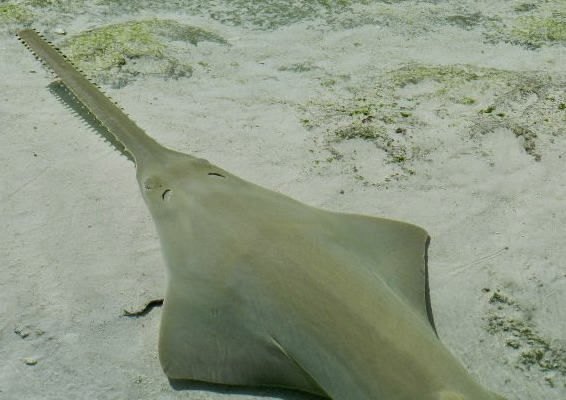
People & Business
Mote Provides Critical Role for Potential Rescue of Smalltooth Sawfish
March 29, 2024 – Sarasota
Mote Marine Laboratory and Aquarium is providing a critical role for the Florida Fish and Wildlife Conservation Commission (FWC) and the National Oceanic and Atmospheric Administration (NOAA) in their response effort to address smalltooth sawfish erratic behavior and mortality in the Florida Keys.
Over the past few months, sightings of “spinning” fish have been reported in South Florida. Along with this abnormal behavior, known as “whirling” in the marine science community, there have also been reports of fish deaths, including 28 smalltooth sawfish as of March 24. Approximately 109 sawfish ranging from 10-14 feet in length have been affected.
The death of smalltooth sawfish in South Florida could have devastating consequences for this critically endangered ray and negatively impact population recovery that has been occurring since the species was listed under the Endangered Species Act in 2003.
Scientists do not yet know what is causing the erratic behavior. NOAA has initiated an emergency response effort with FWC, Mote Marine Laboratory, and other partners including Havenworth Coastal Conservation, Dynasty Marine Associates, Inc., and Ripley’s Aquariums, to possibly rescue, rehabilitate, and release smalltooth sawfish impacted by this mortality event. Investigations into the abnormal fish behavior and deaths by FWC are ongoing and Mote staff, working with FWC, have collected important samples from live distressed sawfish.
Mote played an instrumental role over twenty years ago in providing some of the foundational research that led, in part, to the listing of smalltooth sawfish as the first marine fish placed on the Endangered Species List and designation of Critical Habitat. Now, Mote is acting under the guidance of NOAA and FWC in this partnership mission.
“When Mote scientists based in the Florida Keys began to notice the recent abnormal behavior of rays and other fish species, we became very concerned in particular for the potentially devastating impacts to Florida’s iconic sawfish”, said Dr. Michael P. Crosby, Mote President & CEO. “As a result, we reached out to NOAA and FWC to offer the immediate assistance and support of our expert scientists, vets and specialized marine species quarantine facilities for any response deemed necessary.”
Plan for rehabilitation and release
“We are eager to aid in the effort to help this endangered species, and we will do everything we can to prioritize the well-being of sawfish,” said Dr. Kathryn Flowers, Mote Postdoctoral Research Fellow and Mote’s lead scientist for this initiative. “We have quarantine facilities ready to accommodate rescued sawfish where they would be under observation by qualified personnel under specific care and release guidelines. Attempts to solve this mystery call for robust collaboration.”
While Mote and its partners hope to successfully rescue as many smalltooth sawfish as possible, active rescue and rehabilitation efforts are not always effective in saving stranded animals. If the opportunity arises, and only upon request by FWC and NOAA, Mote would collaborate with its partners to attempt the rescue of afflicted smalltooth sawfish and gather insights into the nature of their distress. The information gathered from these endeavors is vital for comprehending the situation and guiding subsequent efforts.
An effort of this kind has never been attempted before in the United States, and the logistics are complex. Nevertheless, Dr. Crosby pledged that even “without any clear source of financial support, we have committed Mote resources without hesitation to this significant, challenging and unprecedented initiative because this is at the heart of our mission and why Mote exists – using best available science to rescue, restore and conserve our precious marine species, habitats and ecosystems. In the end, our goal is to release healthy sawfish back into the wild.”
How can the public assist?
Report all sawfish observations (healthy, sick, injured, or dead) to (844) 4-SAWFISH (844-472-9347) or sawfish@myfwc.com
Report abnormal fish behavior and fish kills to the Florida Fish and Wildlife Conservation Commission Fish Kill Hotline at (800) 636-0511 or MyFWC.com/ReportFishKill
How can the public help support the Sawfish Rescue Initiative with a donation?
Please go to www.mote.org/sawfish
For more Information on the Smalltooth Sawfish:
Smalltooth Sawfish | NOAA Fisheries
The Endangered Smalltooth Sawfish – Fact Sheet
Historically, smalltooth sawfish were found in coastal Atlantic waters along the southeast coast of the United States, including the Gulf of Mexico, into the Caribbean Sea to South America, and in parts of western and southern Africa. But now Florida is one of the last remaining population strongholds for this species. Major reductions in smalltooth sawfish numbers were mainly due to habitat loss and fishing. Smalltooth sawfish take up to 11 years to reach sexual maturity, slowing their recovery potential. In the wild, they may live up to 30 years or more. One of the largest marine fishes in Florida waters, the smalltooth sawfish was also the first marine fish to receive federal protection by the Endangered Species Act.



You must be logged in to post a comment Login